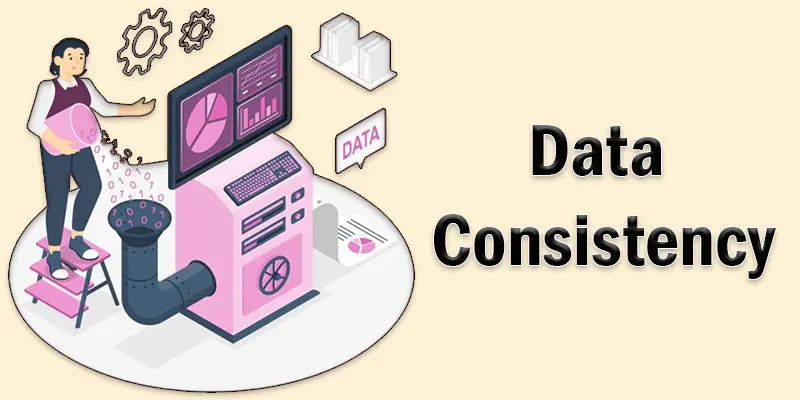Data Consistency Explained: Types, Why It Can Break, and Practical Examples
Published: 30 Apr 2025
Data Consistency
Data consistency means keeping the same data correct and matching across all places. But have you ever wondered why your profile shows your old phone number even after you updated it? This kind of mismatch can lead to confusion, mistakes, and even lost trust—especially in apps, websites, or school systems. Whether you’re managing a small app or using a big platform, inconsistent data can ruin user experience. Imagine updating your info in one place, but it doesn’t change anywhere else—frustrating, right?
Data Consistency Definition
Data consistency refers to the uniformity and accuracy of data across different systems or databases. It ensures that all copies of data remain identical, preventing errors or discrepancies. Maintaining consistency means updates and changes are reflected everywhere, ensuring that the data is reliable and up-to-date.

What is Data Consistency
Data consistency means keeping the same data accurate, correct, and the same across all systems or places where it’s used. When data is updated in one place, it should also update everywhere else to avoid confusion or errors.
Why is it Important?
- It helps avoid confusion.
- It keeps data reliable and trustworthy.
- It’s key for things like banking apps, online shopping, schools, and more.
Types of Data Consistency
Data consistency comes in different types, depending on how quickly and accurately data updates across systems.
- Strong Consistency
- Eventual Consistency
- Causal Consistency
- Weak Consistency
Strong Consistency
No matter where or when data is accessed, strong consistency guarantees that it is always correct and up to date. When you make changes to the data, they are immediately reflected everywhere. This type of consistency guarantees that every user sees the same version of the data at the same time.
Example
In a banking app, when you transfer money, your account balance is instantly updated across all devices, so no matter where you check, you’ll always see the same amount.
Eventual Consistency
Eventual consistency means that data updates across systems may not happen instantly, but eventually, all systems will reflect the same data. It ensures that, over time, any changes made in one place will be synchronized with others. This type of consistency is useful when instant updates aren’t critical, but accuracy is still needed in the long run.
Example
In an online shopping website, if you update your shipping address, it may take a few moments for the change to appear across your account, order history, and delivery system.
Causal consistency
Causal consistency ensures that related changes are applied in the correct order across systems.
Example
If you send a message in a chat app and then edit it, causal consistency guarantees that others will see your original message first, followed by the edit in the correct sequence. This type of consistency is important for maintaining a logical flow of actions, especially in social media and messaging platforms.
Weak Consistency
Weak consistency means that data may not be updated right away across all systems. There’s a delay before changes appear in all places, which can cause temporary mismatches. While it eventually gets corrected, users might see outdated information in the meantime.
Example
If you update your address in an online store, it might take a few minutes for the change to show up in your order history or shipping details.

Why Data Consistency Can Break
Sometimes, data doesn’t stay the same across all systems, and that’s when data consistency breaks. This can happen for a few common reasons
System Errors
- Bugs or crashes in apps or databases can cause wrong or missing data.
Network Issues
- Slow or unstable internet can stop updates from reaching all systems.
Manual Mistakes
- People entering data by hand might type the wrong info or forget to update it in all places.
Poor App Design
- Some apps don’t sync data properly between different parts of the system.
Delayed Updates
- In systems using eventual consistency, updates don’t happen right away, so things may look out of sync for a while.
How to Maintain Data Consistency
Keeping data consistent is important for accuracy and trust.
Use the Same Format Everywhere
- Make sure dates, names, and numbers follow the same style.
- Example: Always write dates like “10-04-2025,” not sometimes “10/04/25.”
Sync Data Automatically
- Use tools or apps that update data in all places at once.
- Tip: Avoid doing it manually—automation saves time and avoids mistakes.
Check for Errors Regularly
- Review your data to catch mismatches early.
- Example: Compare records in different systems to see if they match.
Use Reliable Tools
- Choose trusted software like Mysql, Firebase, or Mongodb to manage data.
- These tools have built-in features to keep data accurate.
Test Before Making Big Changes
- Always test updates on a copy before changing real data.
- This helps prevent breaking anything important.
Real-Life Examples of Data Consistency
- Online Banking: When you transfer money, your bank balance updates immediately across all platforms—mobile app, website, and ATM machines.
- Social Media: If you change your profile picture on Facebook, it updates everywhere—on your feed, in messages, and notifications.
- E-Commerce: When a product’s price is updated in the database, it reflects instantly on the website, app, and any other system showing that product.
- School Records: If a teacher updates a student’s grade, it immediately shows up in the online portal and in the teacher’s records.

Conclusion About Consistency Data
Data consistency is key to ensuring that all your information is accurate and up-to-date across different platforms. Whether it’s your bank balance, social media posts, or school grades, keeping data consistent prevents confusion and builds trust. By following best practices like using the same format, automating updates, and regularly checking for errors, you can maintain clean, reliable data. Consistent data means a smoother experience for everyone!
FAQS Consistent Data
Data integrity is the quality and consistency of data over the course of its lifecycle. It guarantees that unless authorized users alter the data, it will stay accurate, comprehensive, and unaltered. Maintaining data integrity helps avoid errors and keeps systems trustworthy.
Consistent data means that information remains the same across all systems or platforms. Whether it’s a phone number, product price, or grade, consistent data should match everywhere it appears. This avoids confusion and keeps users confident in the system.
A consistent data example is when you update your email address in an app, and it changes everywhere—on your profile, in messages, and notifications. No matter where you check, the data remains the same and correct. This ensures a smooth and accurate user experience.
Data consistency ensures that data stays accurate and up-to-date across all systems or platforms. It’s important for maintaining reliability, especially in systems like banking, e-commerce, and social media. Consistent data helps avoid errors and confusion.
Because it ensures that your data is accurate, dependable, and trustworthy, data integrity is crucial. Without it, systems might show incorrect or outdated information, leading to errors or security issues. It helps organizations make informed decisions and keeps users safe.
In pharmaceuticals, data integrity ensures that drug information, patient records, and research data are accurate and reliable. This is crucial for patient safety, compliance with regulations, and ensuring proper treatment. Mistakes in this data can have serious consequences for health and safety.
Data integrity is everyone’s responsibility within an organization, from IT staff to end-users. Those who handle, store, or modify data must follow proper protocols to keep it secure and correct. In regulated industries, specific roles like data managers or compliance officers ensure integrity standards are met.

- Be Respectful
- Stay Relevant
- Stay Positive
- True Feedback
- Encourage Discussion
- Avoid Spamming
- No Fake News
- Don't Copy-Paste
- No Personal Attacks

- Be Respectful
- Stay Relevant
- Stay Positive
- True Feedback
- Encourage Discussion
- Avoid Spamming
- No Fake News
- Don't Copy-Paste
- No Personal Attacks





